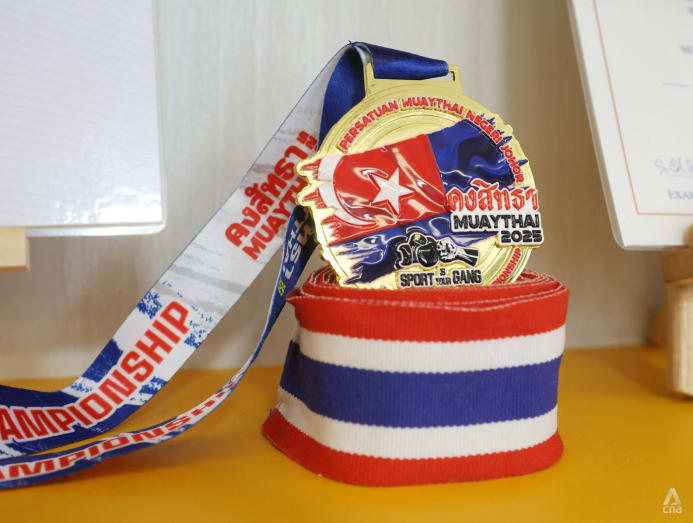Risk, reward and resilience: Why these Singapore parents send their kids to compete in Muay Thai overseas
Singaporean youths as young as eight are making a name for themselves in Muay Thai, competing in Thailand where the sport is deeply rooted. Here's why their parents are supporting their kids even as they acknowledge the risks involved.
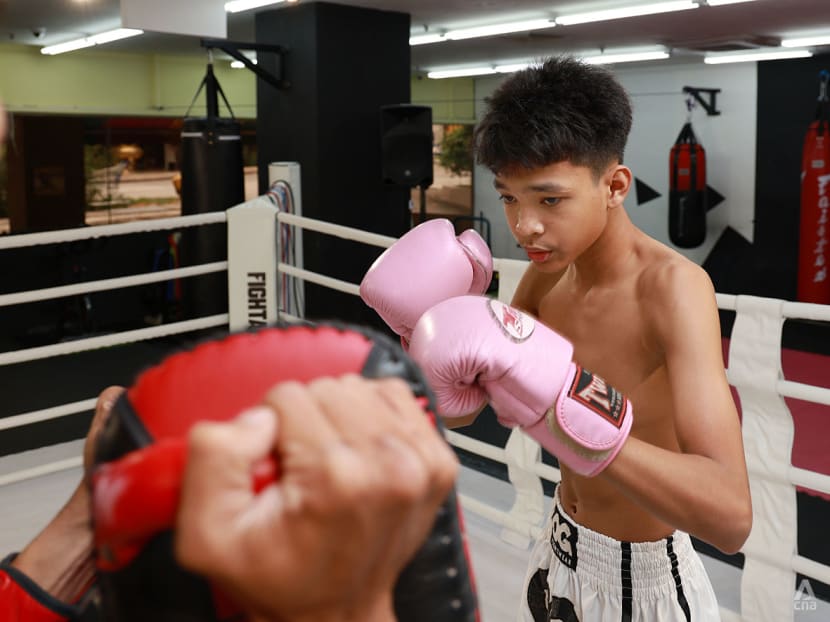
Muhammad Niyaz (pictured) is 14 years old and he has travelled to Thailand for Muay Thai training and competitions. (Photo: CNA/Raj Nadarajan)

This audio is generated by an AI tool.
The beads of perspiration glinting under the lights of the boxing stadium threatened to sting his eyes, but an expressionless Sayyid Al-Tahneem kept focus on his Thai opponent, whom he had just watched brutally knock out another fighter in under 30 seconds.
Clad in black shorts, cobalt blue boxing gloves and neon green ankle supports, Sayyid knew the adrenaline-seeking crowd at Patong Boxing Stadium in Phuket, Thailand was eager to see how a "muay farang" (a Thai term used to describe a foreign fighter) such as him will fare against their own.
However, Sayyid, 12, did not go all the way from Singapore to be a pushover in the Muay Thai ring on Jan 28.
His opponent, standing on home ground, appeared formidable – but the lean Singaporean competitor, having beaten three others in previous matches since last June, knows what needs to be done to earn his first championship belt at the Muay Thai International "Superboy" Championship.
After 10 minutes of enduring his rival's powerful jabs and kicks and countering with a style of fighting that he had honed over a decade of training at a Muay Thai gym in Singapore, Sayyid emerged victorious.
As a referee fastened the bulky belt around his waist, a triumphant smile finally cracked Sayyid’s stoic demeanour.
“I didn’t expect to win ... His kicks were strong,” he recounted to CNA TODAY.
“But I thought, 'It is what it is'. The fight is still going to happen. If I backed out, my hard work would be for nothing.”
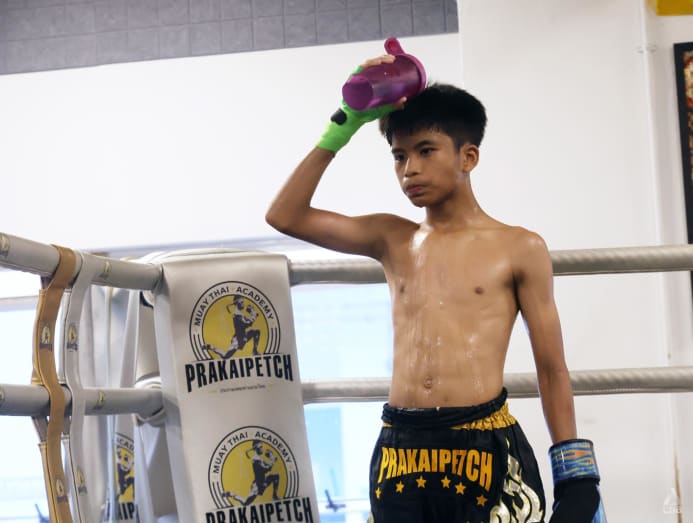
The Secondary 1 student from Meridian Secondary School is one of a handful of promising teenagers flying the Singapore flag in various Muay Thai boxing stadiums in Thailand, where the martial art is a culturally significant symbol of the country's identity.
In 2021, the International Olympic Committee granted full recognition of the International Federation of Muaythai Associations, opening the doors for the sport to be included in the Olympics, though it remains to be seen whether Muay Thai will officially be a part of the 2028 games in Los Angeles.
Speak to the parents of these young Singaporeans, though, and the idea of achieving personal glory on the international stage was not why they encouraged their children to take part in Muay Thai competitions in the first place.
Even though other parents may wince at the idea of putting their own children in a competitive combat sport, for them, it was their way of imparting the values of resilience and forging strong familial bonds with their children, they told CNA TODAY.
After all, boxing stadiums in Thailand do not water down the action when young competitors are involved. In Singapore, child fighters are required to wear protective gear such as shin and head guards, but in Thailand, they wear a mouth guard and boxing gloves as the only forms of protection.
For Sayyid, it is normal to find bumps on his shins after matches, since the legs are often targeted by fighters. He recalled how in his second match, he was dealt with a kick to his thigh so painful that it left him limping back to his hotel.
Despite this, the sight of the championship belt around his waist makes the effort and pain worthwhile.
To find out why these young Singaporeans are donning Muay Thai boxing gloves to compete overseas, CNA TODAY spoke to several young boxers who regularly fight in overseas contests, as well as their parents on how they support their children in their quest for titles.
BEGINNER'S GUIDE TO MUAY THAI FIGHTS
The national sport of Thailand, Muay Thai is known as “the art of eight limbs”. Fighters use their fists, elbows, knees and shins to strike blows on their opponents.
There is no belt system in Muay Thai, unlike other popular martial arts such as taekwondo and judo.
Matches in Thailand have five rounds, which is the traditional format.
To make Muay Thai accessible to TV audiences, international competitions adopt a three-round format, with championship matches having five rounds. Each round lasts two minutes for children, three minutes for adults.
A winner is picked from one of three methods.
- Knockout: The most decisive way to win, in which the winner knocks his opponent unconscious or conscious, but the opponent is unable to get back up and fight within 10 seconds.
- Technical knockout: The referee may end a fight if he deems one of the fighters unable to proceed due to injury or a dominant opponent, and the outclassed fighter wins.
- Points: Similar to boxing, judges use a 10-point "must" system to judge fighters on their performance. This means that the winners of a round must receive 10 points, while the opponents receive nine or fewer points depending on how far their performance lacked behind the winner. Fighters are judged on their ability to land accurate strikes with proper technique and power, ring dominance, damage inflicted, and their balance and control. If both fighters are equally matched, each person receives 10 points and the fight ends in a tie.
In order for the fight to be fair, children are matched by their weight, age and experience level.
International competitions for younger athletes have restrictions. The World Boxing Council Muay Thai division states that certain strikes to the head are banned depending on the age category. For fights with athletes aged 17 and above, head strikes such as roundhouse kicks and upper cuts are allowed.
The council dictates that Muay Thai fighters have to be at least 10 years old to fight in international competitions. Youth competitors must wear protective gear. This is in contrast to the cultural norm in Thailand, where youth fighters wear minimal protection.
To compete for a championship belt, competitors must first fight and win five to six matches at a single venue, each increasing in difficulty.
WHY THEY TOOK UP MUAY THAI
When Sayyid first stepped into a Muay Thai gym at three years old, it was at the behest of his father who enrolled him in classes to learn self-defence at the Prakaipetch Muay Thai Academy. Sayyid still trains there and the academy now has three branches in Singapore.
Sayyid's father, who wanted to be known only as Mr Shahriel and works in the construction industry, said that he was worried his son’s small and skinny frame would leave him vulnerable to bullying.
On why Muay Thai instead of other sports, Mr Shahriel, 60, said that it was inspired by his own experience dabbling in the sport when he was younger.
Likewise, the Mustafa brothers Niyaz, Nufail and Naushad (14, 12 and 10 years old), was introduced to Muay Thai at a young age by their father Mustafa Kamal, 37, who had been training since his teens.
Today, the trio train at their father’s gym, Prime Fight Gym. Only Niyaz has fought matches in Thailand. Mr Mustafa hopes that Nufail and Naushad will follow suit.
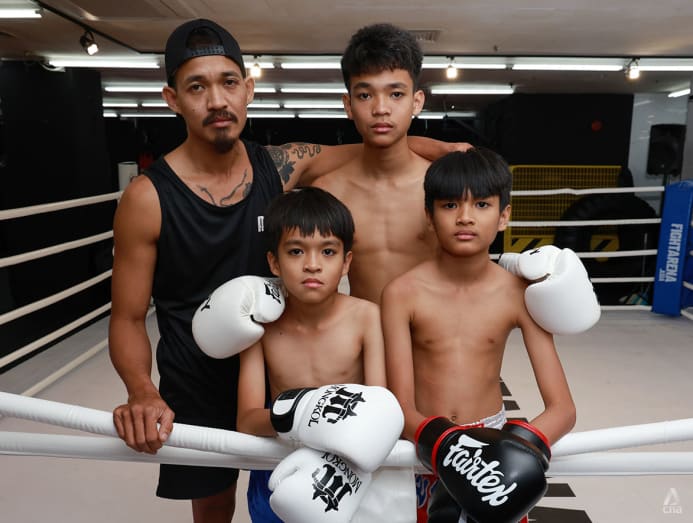
As for siblings Qarizh Fadel, eight, and Qarirah Fadelia, seven, their interest in Muay Thai blossomed because of family reasons as well.
Their mother, preschool teacher Nur Qasidah Kamijan, recounted how two-year-old Qarizh would watch ONE Championship matches – a martial arts competition – on TV with his parents. Imitating her brother, Qarirah also followed suit later.
"Qarizh and Qarirah showed interest in Muay Thai so we wanted to sign them up for classes immediately, but there were no classes for their age group," Mdm Qasidah, 30, said.
While the couple waited for the siblings to grow older, they bought a children-sized punching bag and gloves set for them to play with at home. The sibling duo started attending Muay Thai classes at five and four years old.
Besides weekly training at LFMT Fight Club in Geylang, Mdm Qasidah and her husband Mohammad Fadeli Jeffridin also train their children at home three times a week. The couple earned a Fit Muay certification, where they learnt how to hold kicking pads to aid their children’s technique training.
While most parents might baulk at seeing their children throw punches at each other, for Mdm Qasidah and Mr Mohammad Fadeli, it is just another normal day of training for their children.
Qarizh and Qarirah are sparring partners due to their small size and young age, their parents said.
The siblings jostle in the corner of their living room and practise their Muay Thai techniques, with their parents giving instructions while watching on the side.
“Qarizh knows not to go too hard on his sister. He will restrict his strength when they are sparring,” Mdm Qasidah added.
Speaking to CNA TODAY after returning last week from the Johor Muaythai Championship in Malaysia, where Qarizh scored a gold medal and Qarirah a silver, their proud mother said that her son was fearless in the competition but was more concerned for his sister's match.
“His legs were shivering when he watched his sister fight. I’ve never seen him like that," she recalled with a laugh.
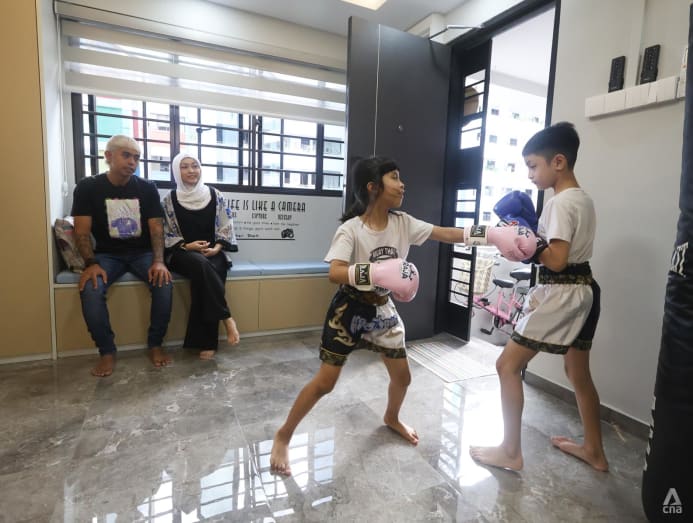
The presence of young Singaporeans in the competitive Muay Thai scene may be small, but it is a reflection of the growing popularity of the sport among children in Singapore.
Two gyms approached by CNA TODAY said that interest towards Muay Thai has been increasing in recent years.
For example, Prakaipetch Muay Thai Academy's founder Davies Teo said that his gym's revenue had increased by 20 per cent yearly since 2022.
The number of children who attend these self-defence classes has also shot up, the gym owners said.
Ms June Thein, founder and owner of mixed martial arts gym Impact MMA, said that the industry could not ignore the growing demand for children's classes.
Her gym started its first children's Muay Thai classes six months ago, alongside its other Muay Thai and Brazilian jiu-jitsu offerings for adults.
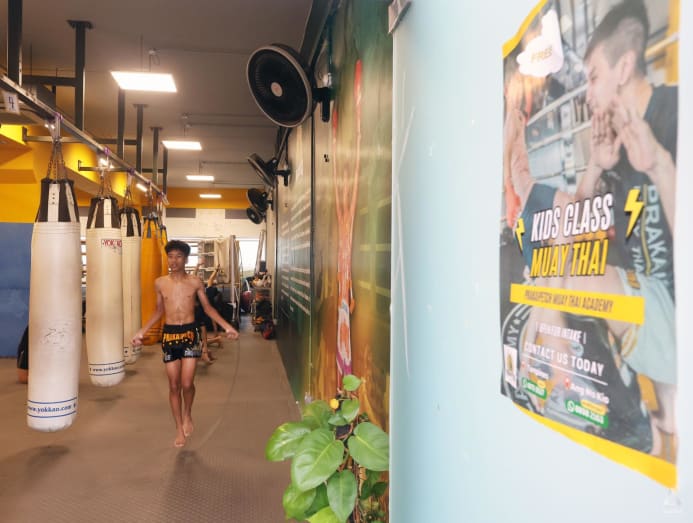
Besides the popularity of competitions for mixed martial arts, “an increased awareness of bullying” has led parents to sign their children up for self-defence classes, Mr Teo from Prakaipetch Muay Thai Academy said.
A study conducted by the National University of Singapore and Singapore Children’s Society last year found that one in four upper primary students were victims of bullying.
Agreeing, Ms Thein said that Muay Thai is a combat sport where a fighter’s ability to do well “depends entirely on how well they've trained to be in a real fight situation”. This makes it a practical choice for anyone who wants to learn self-defence, she added.
OVERSEAS TRAINING AND COMPETITIONS
Five of the six young fighters interviewed by CNA TODAY have just started fighting competitively in the past year, with 14-year-old Niyaz making his competitive debut when he was eight.
Like Qarizh and Qarirah, Niyaz also took part in the Johor Muaythai Championship earlier this month, bagging the Best Male Youth Boxer Award in addition to a gold medal.
As child competitors are matched based on their weight, age and experience level, it was challenging to find a peer in the ring in Singapore.
Therefore, Muay Thai competitions for children naturally gravitate overseas to Malaysia and Thailand, where there is a bigger pool of children to train with and compete against each other.
For Mr Shahriel, he was initially hesitant when Sayyid's coaches suggested that his son pursue Muay Thai competitively because of the risk of injury.
"I was apprehensive because I was worried about my son. I talked to him first and let him know there’s a risk of severe injuries, which will affect his development," he added.
It was only after Sayyid told him that he wanted to take up the challenge and “get a taste of a real fight” that Mr Shahriel agreed to let his son take part in competitive bouts in Thailand.
The father admitted that he still gets nervous when watching every one of Sayyid's matches, but his worries are assuaged each time he sees his son refuse to concede to his opponent and get back on his feet after falling.
In general, the parents of all the children who spoke to CNA TODAY were confident about the safety and professional conduct of matches in Thailand.
Mr Mustafa said that in his two decades as a Muay Thai fighter, he has seen how referees are extra cautious in matches involving younger fighters, stepping in more quickly and decisively at any risk of severe injury.
As for training, Sayyid still primarily works out in Singapore. The other children train overseas, which can be a gruelling experience.
During the June and December school holidays, the Fadelis and Mustafas jet off to Thailand for training. This includes pad training, where athletes stimulate kicks and punches they would use in competition on kicking pads.
The Fadelis have visited gyms in Nakhon Si Thammarat in southern Thailand and Chiang Mai in northern Thailand, while the Mustafas trained in Nakhon Si Thammarat, Bangkok and Phuket.
So far, Mr Mustafa has been taking just his two older sons Niyaz and Nufail to train in Thailand, though he hopes to eventually have 10-year-old Naushad train along with his siblings when he is older.
It is not cheap to keep up with this sport there. Monthly passes at a Thai gym typically cost 10,000 Thai Baht (S$398), with two sessions a day for a total of about 60 sessions.
In comparison, prices are lower in Singapore, with the market price for a monthly pass costing around S$260, though pay-per-entry passes cost more, Mr Mustafa said.
Despite the higher cost of training overseas, the parents believe that it is well worth the price.
“Here, you can get distracted because of lifestyle and daily commitments,” Mdm Qasidah said. "In Thailand, it's more focus-oriented, a repetition of 'eat, sleep, train’."
Mr Mustafa said: “In Singapore, you can get only one round of pad training. In Thailand, you get three to five because there are more trainers. The intensity is harder and you build stamina and strength faster.”
THE NEXT GENERATION OF FIGHTERS
With the rising profile of Muay Thai at the international level, the youngsters who spoke to CNA TODAY shared their dreams of representing Singapore on the world stage, even if there is still a long journey to get there.
Singapore already has a number of accomplished adult Muay Thai fighters, such as 32-year-old Cheryl Gwa, who clinched the country’s first silver medal at the Muaythai World Championships last November.
For youths to be able to reach that level, they first need to prove themselves in lower level competitions such as the Amateur Muay Thai Championship (AMC), which is held in Orchard Plaza's Club Lunar and slated for Feb 22 this year.
Singapore MuayThai Federation's secretary-general Chris Wong told CNA TODAY that the best athletes from AMC will be selected to represent Singapore in international sporting competitions such as the Southeast Asian Games.
With this in mind, Niyaz, Sayyid and Qarizh have their eyes on the AMC to fight for a spot on the nation's youth team, which is for athletes aged 10 to 17.
With the competition just a week away, the young fighters have been ramping up their preparations, spending five to seven days a week training.
As they dream of joining the ranks of their idols such as ONE Championship winner Rodtang Jitmuangnon one day, their parents plan to do whatever it takes to support them.
“I take them to fights for experience, experience, experience. It’s okay to lose. Most importantly, they should have fun and learn from it, because there are many world champions who have had losses,” Mr Mustafa said.
As for Sayyid, the boy is aware that many people are watching him climb the Muay Thai ranks. On TikTok, his training videos are watched by close to 45,000 followers. His seniors from secondary school have approached him, calling him an inspiration to them.
Although he feels more pressure to do well, the 12-year-old said that he uses his peers’ encouragement to motivate himself and to keep performing at his best.
“To represent Singapore is a dream come true,” Sayyid said. “As the saying goes, ‘Train until your idols become your rivals’. I want to achieve more than what I have now.”
